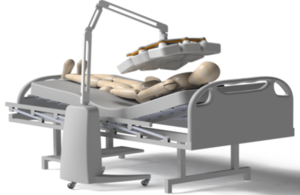Stargazing technology used to spot cancer
Cancer could be detected in patients far earlier by using the same technology used to observe stars millions of miles away.

Credit: Adaptix Limited
Cancers are often missed on traditional 2D X-rays so are sometimes only discovered later when the disease is more advanced and difficult to treat.
Now experts have been granted £1 million of UK Space Agency funding, following a competition to celebrate the NHS’ 70th birthday, to develop a pioneering portable 3D medical X-ray machine, based on technology used to study stars in distant galaxies.
The equipment will allow doctors to get a more comprehensive view of areas where they suspect tumours are growing, aiding more effective treatment and earlier diagnosis.
Miniaturised, portable and connected through satellites, the kit could also allow patients to be scanned in doctors’ surgeries, reducing the need for trips to hospital for busy X-ray and CT scanners.
Science Minister Chris Skidmore said:
The challenge of working in space focuses some of the UK’s most brilliant minds. These experts can also help transform our lives for the better here on Earth.
The huge potential of space technology isn’t just about reaching out into the universe: it’s here on earth that its greatest impact can be seen, from 5G to tackling climate change or ensuring we can all benefit through space-inspired healthcare technologies such as these.
We have committed to spending 2.4% of GDP on research and development by 2027, with space being at the forefront of our ambitions, and it’s in the potential of medical advances such as these that we can see the potential massive benefits of spending more on the technology of the future, helping us to live healthier, happier lives, for longer. This is our modern Industrial Strategy in action.
The scanner relies on technology developed for space; including field emitters etched onto silicon wafers used previously in ion thrusters and X-ray optics deployed on star mapping spacecraft such as the European Space Agency’s XMM Newton mission, in which the UK played a major role.
The project will help to address the key NHS 70th Anniversary Challenges of managing long term conditions, including joined-up health and care services, earlier diagnosis of cancer and transforming GP services and other primary care.
Launched in June 2018, this joint initiative between the UK Space Agency, NHS England and the European Space Agency, asked innovators to bid for a share of £4 million to turn technology originally designed for space into medical applications that improve NHS treatment and care.
Health Secretary Matt Hancock said:
Technology has enormous potential to save lives. This is a brilliant example of how innovators can work with the NHS to help save lives with more early diagnosis of cancer.
It’s all part of our NHS Long Term Plan, building on the work of NHSX, our new organisation built to drive new technology through the NHS. We will deliver by opening the doors of the NHS to the best technologies like this, to build a preventative, personalised and world-leading health and care service.
Professor Tony Young, NHS England’s national clinical director for innovation, said:
Last year as we celebrated the NHS’s 70th birthday we challenged industry to bring technology designed for outer space into the NHS, and using stargazing technology to spot cancer is exactly the type of advanced innovation that could improve care for patients by speeding up diagnosis and helping to deliver our Long Term Plan which will save half a million lives.
Nick Appleyard, Head of Business Applications at the European Space Agency (ESA) said:
This is a wonderful example of how ESA supports innovation. The company that developed the portable X-ray machine, Adaptix, started life in ESA’s Business Incubation Centre at Harwell in Oxfordshire and has grown to become a successful and innovative enterprise.
Mark Evans, CEO of Adaptix Limited, said:
Being incubated at the world-renowned Rutherford Appleton Laboratory in Oxfordshire’s Harwell Campus, a major centre for the UK Space industry, has given us access to fantastic facilities and leading minds to support the development of our space-heritage technology.
In addition, we have been fortunate to have received significant support from InnovateUK, the European Space Agency and the National Physical Laboratory - organisations that provide a significant capability to high-science based early-stage companies such as Adaptix.
Our vision is to create a business that will Transform Radiology through the export of high-science-content high-value products to achieve revenues of more than $100m. X-ray is the primary diagnostic in healthcare - one day we hope that Adaptix technology will touch the lives of everyone that you know and being supported by the NHS through this grant will help our team realise this vision.
The Adaptix 3D X-ray machine is the first of four projects receiving a share of a £4 million innovation fund drawn from ESA’s Business Applications and Space Solutions programme, to which the UK is the largest subscriber. The three other winning applications will be announced in the coming weeks.
Last month the UK Space Agency revealed that every £1 of public spending generates up to £4 in value for the recipients in the space industry, with additional benefits to the UK economy.
The demanding environment of space means that investments in the sector generate new knowledge and innovations that extend far beyond the space industry. For example, satellites provide services that enable a wide range of economic activities, supporting industries worth £300 billion to the UK.